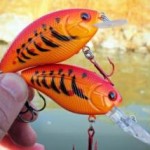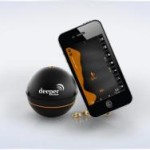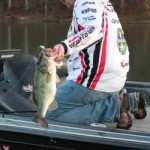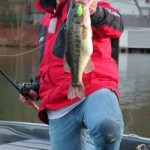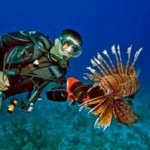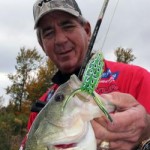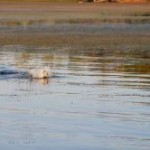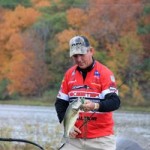Classic 2014: Livingston LARGE
by Russ Bassdozer
from The Fishing Wire
Most every Classic day, Howell caught a lot of fish on the Rapala DT-6 which is a great cold water bait made of wood. When a medium-runner is called for in cold water, the DT-6 is one lure that almost every bass pro uses (whether they are sponsored by Rapala or not). The DT-6 was in Ike’s Demon – a bright red crankbait color. He also caught a key 6-pounder on a Fizzle brand of bladed swim jig on Day Three.
History however will remember Randy Howell and Livingston Lures as the winners of the 2014 Classic.
On Day Three, Howell livewelled his first 20 lbs for the day on the Rapala DT-6 but as the day progressed, his fish moved deeper than could be reached with that crankbait. As the model number DT-6 implies, it dives to a maximum of 6 feet deep.
Howell had located the bass hanging around the riprap surrounding Guntersville’s Spring Creek bridge. He could see the arches of bass and tons of shad on his Lowrance SideScan about 15 feet deep hanging off and looking up at the 8 foot deep riprap rock line where he had been catching them earlier. He could see the streaks and noodles coming up and down from the deeper water to the rocks and back down.
Randy got out a box of Livingston Lures prototypes he had been given only a few days earlier. He was looking for a deeper-runner in a bright crawfish orange/red color that’s perennially popular on Guntersville. The prototypes had been in his boat all week unused. When he tied on the one deep-runner in the box, he flipped it in the water alongside the boat to see what it looked like. It vibrated really hard, wobbled and rattled his rod tip. In that muddy water, Howell knew it was going to catch them. The bass were everywhere on his graph in the last few hours of the tournament. He landed 30 or 40 bass on the Livingston medium-runner which dives about 8-10 feet deep. The bass just choked it, that hard vibration and that bright color with that red and orange combined in that dirty, muddy water was just perfect. Howell culled every bass he had caught earlier on the DT-6 except one, ratcheting up to his 29 pound Classic-winning weight with the Livingston prototype.At Livingston, the company and pro staff are prototyping a lot of new lures right now. Howell estimates there are maybe six different models although they may be testing up to several different configurations of each in order to determine which is best. Overall, the Livingston Lures pros had received up to 30 prototypes on the day before the Classic, mostly different configurations to test and give feedback to the company.
Howell said he felt like he did what he needed to do for Livingston Lures by pulling that bait out, having never used it before. The 2014 Classic champ believes Livingston is a great company and a great family of people that are trying to love our sport and really promote our sport. To win on their lure like that was the best feeling in the world for Howell because he wanted to put Livingston Lures on the map.
He has such a love for the people at Livingston because of their commitment to our sport and to Randy Howell and his family personally that he wanted to use their prototypes as a part of this Classic and the results exceeded even Howell’s expectations. The prototype diver fit exactly what he needed to come from behind to win the 2014 Classic.
As we said, he started the morning with the Rapala DT-6. At this time of year in February when the water is cold, a subtle wood bait can be good, especially up shallow. Then when they move out deeper, you need a little more vibration and sound – and that’s where the Livingston came into play.
Howell is a strong proponent of sound. He had his boat’s HydroWave electronic sound attraction unit turned up loud all day on 30 second intervals emitting feeding stimulation sounds in that dirty water.
Likewise, Howell feels the sound unit embodied within Livingston Lures is a huge attraction to fish. The croaking sound emitted by a Livingston Lure is the same decibel level recording as a natural baitfish sound that’s given off, said Howell. He’s watched fish in seminar demonstration tanks come to Livingston Lures solely due to the sound they emit, so he knows they hear the recording and are attracted to it, and in muddy water like on Guntersville during the Classic, that electronic sound is especially good said Howell.
As a media observer during the Classic, I had the chance to eyewitness the Livingston Lures prototypes in action catching bass on Guntersville. I saw up close how the medium-runner like Howell used swims. Obviously its action is good; no, make that great enough to win the Bassmaster Classic. There’s no higher accolade than that. However, the action of the Livingston Lures shallow-running squarebill prototype looks even better. Hefting the prototypes in my hand, at first I couldn’t tell and didn’t believe the sound-emitting electronic units were inside because the crankbaits were so lightweight. I had to dip them in the lake (water activates the sound system) in order to prove to myself that the new, lightweight electronic sound-emitting units really were inside these baits. Clearly these new prototypes, once tested and finalized, will prove to be a huge breakthrough for Livingston Lures and for savvy bass anglers worldwide.
A few months before this Classic in a conversation I enjoyed with Basil, one of the two Battah brothers that head up Livingston, Basil said he hoped to have the sport’s top professional anglers begin to recognize Livingston Lures technology-enhanced baits as the wave of the future – that these lures are not just gimmicks. Certainly Randy Howell just accomplished that. The lure company and its techno-marvels are suddenly and emphatically Livingston LARGE for the entire world to see.
Livingston lures really do work and are not a gimmick. They’re the real deal. Randy Howell’s 2014 Classic win will change any preconceived notions of any anglers that don’t yet believe that Livingston Lures represent the cutting edge and future of our sport.

